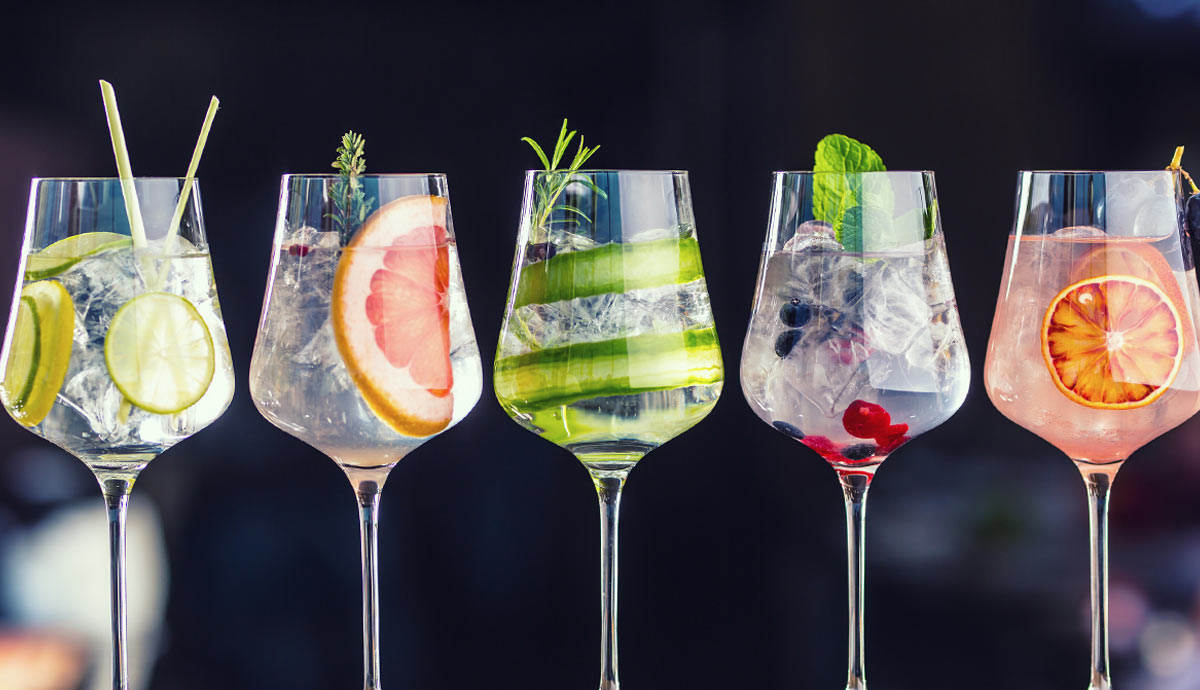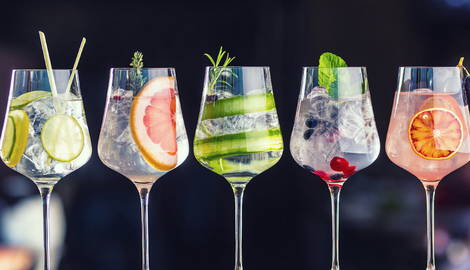
It is well known that the national drink of England is tea. The country, however, also has a national alcoholic drink, and that drink is gin.
Originally conceived as a medicinal drink, gin took hold of England in the 17th century and never really let go. It served as a drink for people across the class spectrum, from those wishing to drown their sorrows to those wishing to relax in a summer garden.
Since then, gin has become a popular alcoholic drink in many countries around the world and has been the inspiration for craft enterprises wishing to bring something different to the shelves of liquor stores.
What Is Gin?

Gin is a colorless clear liquor made from grain mash, to which juniper berries are added for flavoring. There are various similar types of gin, with different countries having different laws as to what can be labeled as gin. In the United States, for example, gin is legally classified as an alcoholic beverage of no less than 40% alcohol with the characteristic flavor of juniper berries.
While gins may be sweetened using various ingredients and methods, a characteristic of “London dry gin” is that it contains no form of sweetening agent, and the flavor is purely botanical.
Sometimes known as “Dutch gin,” jenever is a similar alcoholic spirit that serves as the national drink of the Netherlands. Popular varieties of it have a malty taste, and it is often aged in barrels previously used for American whiskey. The flavor can be reminiscent of the type of grain used to make it, usually barley, wheat, or rye. As such, the flavor of Oude Jenever can have a malty, woody, and smoky taste that resembles whiskey.
“Sloe gin” is not, in fact, gin. It is a red-colored liquor based upon gin and, in Britain, is flavored with blackthorn fruit (sloe), a close relative of the plum. Sloe gin is also produced in the United States, with variations using fruits similar to the blackthorn.
The Forerunners of Gin

The key ingredient to gin is the juniper berry, which gives gin its distinctive flavor. It is thought that Italian monks were using juniper berries to flavor spirits as early as the 11th century. Juniper was considered a medicinal herb and was a common ingredient found in doctors’ kits. Juniper-flavored spirits were given to patients for a wide variety of ailments. Being alcoholic, however, the medicine became more popular than it should have been.
The influence of the juniper berry in creating alcoholic drinks, however, originated in Holland and was introduced to the British Isles in the 17th century. Before it was introduced to the British Isles, it was introduced to English soldiers in 1585 who were stationed in Antwerp to fight the Spanish during the Eighty Years’ War.
It was handed out to soldiers about to enter combat. It is thought that the term “Dutch Courage” originated from this event.
This alcoholic beverage was jenever. Inspired by this drink, other spirits emerged, flavored with anise, caraway seeds, and other botanicals. However, they all had juniper added into the mix. By the 17th century, these drinks became widely popular in England and were sold as medicines for a host of ailments such as gallstones, kidney problems, gout, and lumbago.
Production Begins in England

In 1638, King Charles I created the Worshipful Company of Distillers in London, and forms of jenever began being produced in the English capital. Although success was marked, the spirit was not yet the icon of English culture that it grew to be.

A huge influence on the gin industry was provided by King William III, better known as William of Orange, the king of Holland, who also became king of England and Ireland on January 22, 1689. He promoted the drink in England, and it was heartily adopted. This massive surge in the popularity of gin became known as the Glorious Revolution, and London became the epicenter of gin production.
The Gin Craze

In the 18th century, the “London Gin Craze,” as it was known, created huge problems in London. It was similar in nature to the drug-fueled epidemics of today, and it caused concern enough for the English government to enact strict laws governing the production and consumption of gin. For the people of London, who were used to nothing stronger than beer, the effects of gin were disastrous, so much so that gin earned the nickname of “mother’s ruin.”
The scourge was taken seriously by the government. In 1729, the first “gin act” was passed. Seven acts followed, each trying to limit gin sales, and each time the populace found legal ways to work around the acts.

In 1734, a notorious murder brought widespread social resistance to gin in society. On January 29, Judith Defour and her two-year-old child, Mary, lived at the Bethnal Green Parish Workhouse, where Judith also worked spinning thread. One day, the workhouse had dressed Mary in a new petticoat. Judith took her daughter out for a few hours, but when she came back to the workhouse, she was in a drunken state, and her daughter was nowhere to be found. After being interrogated, Judith admitted she had left her daughter in a field. Upon investigation, Mary was found dead. Judith had strangled her own daughter and sold her clothes to buy gin.
Judith was found guilty of murder and sentenced to death.
This incident drew huge attention, and the people of London began intense campaigns to end the abuse of gin in their communities. The government even hired informants in order to catch those flouting the acts.
The Gin Act of 1736, which imposed immensely expensive fees on gin producers, failed to bring about the necessary changes. The lawmakers tried to reduce the production and consumption of gin by making it illegal to produce gin without an enormously expensive license. The result was that only two people bought a license, while other distillers continued to ply an illegal trade and were producing low-quality gin that was often toxic.

As gin gripped the London populace, the birth rate declined so much that it dipped below the death rate. Gin was to blame. Drunken parents neglected their children, and levels of impotence rose as people became too drunk to function in society. Efforts to control the production of gin ended up creating an illegal network of gin producers who made their cheap gin, often with highly toxic substances such as turpentine and sulphuric acid.
The result was a very sick population. Poor people spent what little money they had on getting drunk and then spending the rest of their time unconscious, lying on straw in the back of gin shops. Meanwhile, informants were being targeted, and violent crime surged as a result of the illegal gin trade.
To hide their activities, gin vendors introduced the “Puss and Mew.” They would barricade themselves in a room and transact with customers via a drawer through which money and gin would pass. The trend was for customers to approach the drawer, say “puss,” and insert money into the drawer. The vendor would respond with “mew,” take the money, and submit gin through the drawer. Another form of this enterprise involved a slot for money and a pipe through which the vendor could pour the gin.
The symbol of an old tom cat was often used to mark these vending points, and as a result, cats became associated imagery with the gin trade. A form of sweeter gin called “old tom” was also invented and proved extremely popular at the time. This form of gin became much less popular after the London Gin Craze but has experienced a resurgence in recent years, especially in the craft gin market.

To combat the toxic gin and the surge in violent crime, the gin trade had to be made legal again, and the Gin Act of 1736 was repealed in 1743.
Over the next few years, the government saw slow progress in controlling the epidemic. Licenses and tariffs were made affordable, and businesses became more legitimate and respectable. The criminal element faded as it became an unprofitable enterprise.
Nevertheless, gin continued to be a serious problem for the people of London. Crop failure in 1757 gave the government an unexpected success. Due to the lack of grain, the distilling of gin was banned. A poor harvest the following year resulted in the ban being extended. When the ban was finally lifted in 1760, costs of excise duties increased the cost of the final product, and it became more expensive to get drunk on gin than on beer. London society returned to a similar state of sobriety as before the London Gin Craze.
With the increase in price, gin became a more attractive drink to the upper classes.
Gin Spreads to the Colonies

Gin became a staple of British colonialism, especially in warmer climes. To ward off mosquitoes and to treat malaria, a bitter medication called quinine was imbibed by adding it to tonic water. To cut the bitter taste, gin was added to the mixture and thus was born the “gin & tonic,” which has become a popular drink in many places around the world, and is still associated with British colonialism.
In places such as Kenya and India, where malaria was a particular problem (and still is), gin was in very high demand.
Throughout the 19th and 20th centuries, many entrepreneurs experimented with gin as a base for liqueur.
In 1823, James Pimm introduced his brand of gin-based liqueur, which became known as Pimm’s No.1 Cup. Flavored with spices and citrus, the drink became popular mixed with other beverages such as lemonade.
Many other varieties of gin were also developed during this time, including sloe gin, which was flavored using the blackthorn fruit.
Gin in the 21st Century

Through the 20th century, gin remained a popular drink, especially in Britain, where it formed part of British culture. From 2013 onwards, however, there has been a significant surge in the popularity of the drink as the lack of competition invigorated entrepreneurs to take up their own distilling businesses. The rise of craft gin has boomed as a result, and many small companies operate in Britain and in areas where British colonization left a cultural mark on the population, such as in South Africa and Australia.

Today, gin is considered a fashionable drink and has become popular with younger generations. This is due in large part to the rise in the craft gin industry, which has marketed itself towards a broad demographic. This is especially true in South Africa, where craft gin has seen unprecedented growth. The gin market in South Africa reached US$36.6 million in 2023 and is expected to grow by over 14% annually over the next few years.

Gin continues to play a significant role in alcohol sales and consumption across the world. It is a popular drink in many European countries, the United States, the Philippines, Japan, India, and South Africa.
It is a vital ingredient in many cocktails, such as the Negroni, the Tom Collins, the classic G&T, and many others. As such, gin will remain a staple for bartenders the world over.










